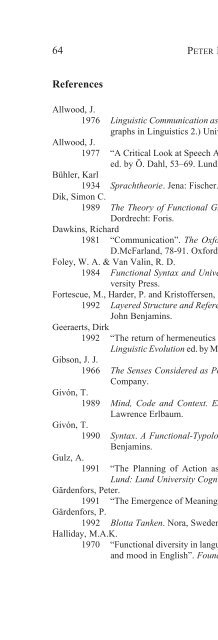Cognitive Semantics : Meaning and Cognition
Cognitive Semantics : Meaning and Cognition
Cognitive Semantics : Meaning and Cognition
You also want an ePaper? Increase the reach of your titles
YUMPU automatically turns print PDFs into web optimized ePapers that Google loves.
SPACE AND TIME 137<br />
mal] with the value ‘now’, i.e. tense is deictic, while sequencing is the ordering<br />
of events <strong>and</strong> situations with respect to each other. With respect to tense, some<br />
languages only distinguish [+Proximal] from [-Proximal], i.e. ‘now’ from<br />
‘then’, no matter whether ‘then’ is in the future or in the past. Such languages<br />
do not make use of a time line of tense. Correspondingly, Traugott claims, if a<br />
language only distinguishes [+Initial] from [-Initial], it does not make use of a<br />
time line of sequencing. (For a criticism of Traugott’s attempt to transfer the<br />
distinction between expressions with <strong>and</strong> without a time line from the time line<br />
of tense to the time line of sequencing (1978: 379-380), see Engberg-Pedersen<br />
1993: 91.)<br />
On the two time lines ‘earlier’ is always to the left, <strong>and</strong> ‘later’ to the right,<br />
but [-Front] is to the left (‘earlier’) on the time line of tense, while [-Front] is to<br />
the right (‘later’) on the time line of sequencing. The difference in the value of<br />
the feature [Front] on the two types of time lines can most easily be understood<br />
as a difference in whose “front” is referred to: on the time line of tense, [Front]<br />
should be interpreted as referring to the speaker’s front-back orientation; on<br />
the time line of sequencing, [Front] refers to time’s front-back orientation. In<br />
order to assign front-back orientation to time on the time line of sequencing,<br />
Traugott needs a reference point to the left of the time line of sequencing:<br />
when Event 1 is before — or precedes — Event 2 , both must be seen from a<br />
TENSE:<br />
[-Proximal] (then) [+Proximal] (now) [-Proximal] (then)<br />
T--------------------------------------------------------------------------------------------------T<br />
[+Prior] (past) [-Prior] (future)<br />
Source Goal<br />
come → go →<br />
[-Front] (behind, back) [+Front] (forward, ahead)<br />
SEQUENCING:<br />
[+Initial] (E1, first) [-Initial] (E2, second)<br />
T--------------------------------------------------------------------------------------------------T<br />
[+Prior] (earlier) [-Prior] (later)<br />
[+Front] (before) [-Front] (after)<br />
← preceding ← following<br />
Figure 3. The time line of tense <strong>and</strong> the time line of sequencing (Traugott 1978: 378 <strong>and</strong><br />
382).















